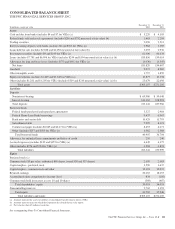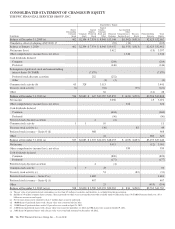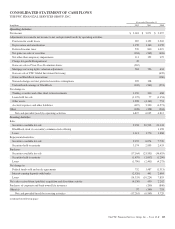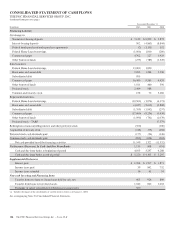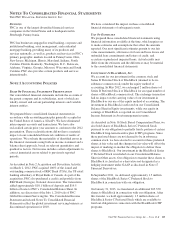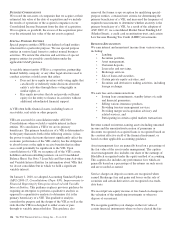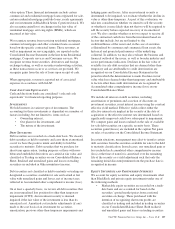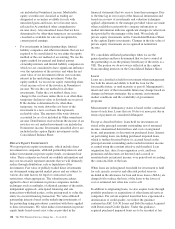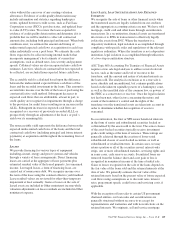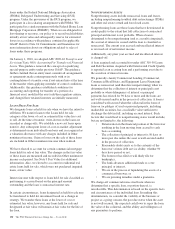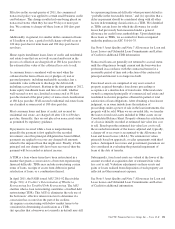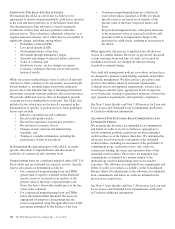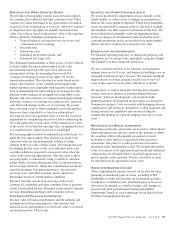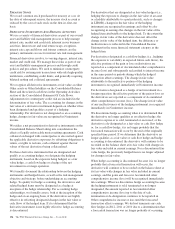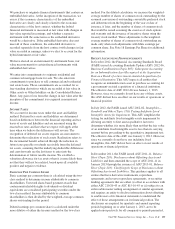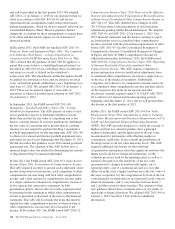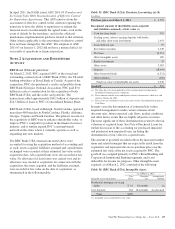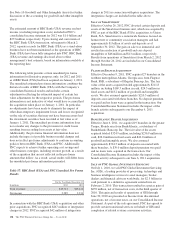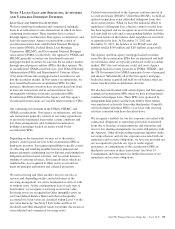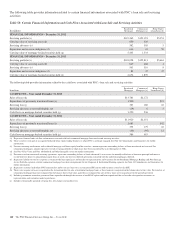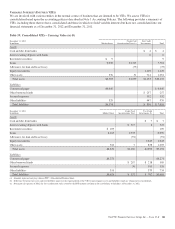PNC Bank 2012 Annual Report Download - page 150
Download and view the complete annual report
Please find page 150 of the 2012 PNC Bank annual report below. You can navigate through the pages in the report by either clicking on the pages listed below, or by using the keyword search tool below to find specific information within the annual report.Effective in the second quarter of 2011, the commercial
nonaccrual policy was applied to certain small business credit
card balances. This change resulted in loans being placed on
nonaccrual status when they become 90 days or more past
due. We continue to charge-off these loans at 180 days past
due.
Additionally, in general, for smaller dollar commercial loans
of $1 million or less, a partial or full charge-off will occur at
120 days past due for term loans and 180 days past due for
revolvers.
Home equity installment loans, lines of credit, and residential
real estate loans that are not well-secured and/or not in the
process of collection are charged-off at 180 days past due to
the estimated fair value of the collateral less costs to sell.
A consumer loan is considered well-secured when the
collateral in the form of liens on (or pledges of) real or
personal property, including marketable securities, has a
realizable value sufficient to discharge the debt in full,
including accrued interest. Starting in the first quarter of 2012,
home equity installment loans and lines of credit, whether
well-secured or not, are classified as nonaccrual at 90 days
past due instead of the prior policy of nonaccrual classification
at 180 days past due. Well-secured residential real estate loans
are classified as nonaccrual at 180 days past due.
Most consumer loans and lines of credit, not secured by
residential real estate, are charged off after 120 to 180 days
past due. Generally, they are not placed on nonaccrual status
as permitted by regulatory guidance.
If payment is received while a loan is nonperforming,
generally the payment is first applied to the recorded
investment; once this principal obligation has been fulfilled,
payments are applied to recover any charged-off amounts
related to the impaired loan that might exist. Finally, if both
principal and any charge-offs have been recovered, then the
payment will be recorded as interest income.
A TDR is a loan whose terms have been restructured in a
manner that grants a concession to a borrower experiencing
financial difficulty. TDRs may include restructuring certain
terms of loans, receipts of assets from debtors in partial
satisfaction of loans, or a combination thereof.
In April 2011, the FASB issued ASU 2011-02 Receivables
(Topic 310): A Creditor’s Determination of Whether a
Restructuring Is a Troubled Debt Restructuring. The ASU
clarifies when a loan restructuring constitutes a troubled debt
restructuring (TDR). This ASU (i) eliminates the sole use of
the borrowers’ effective interest rate test to determine if a
concession has occurred on the part of the creditor,
(ii) requires a restructuring with below market terms to be
considered in determining classification as a TDR,
(iii) specifies that a borrower not currently in default may still
be experiencing financial difficulty when payment default is
“probable in the foreseeable future,” and (iv) specifies that a
delay in payment should be considered along with all other
factors in determining classification as a TDR. We identified
as TDRs certain loans for which the allowance for credit
losses had previously been measured under a general
allowance for credit losses methodology. Upon identifying
those loans as TDRs, we accounted for them as impaired
under the guidance in ASC 310-10-35.
See Note 5 Asset Quality and Note 7 Allowances for Loan and
Lease Losses and Unfunded Loan Commitments and Letters
of Credit for additional TDR information.
Nonaccrual loans are generally not returned to accrual status
until the obligation is brought current and the borrower has
performed in accordance with the contractual terms for a
reasonable period of time and collection of the contractual
principal and interest is no longer in doubt.
Foreclosed assets are comprised of any asset seized or
property acquired through a foreclosure proceeding or
acceptance of a deed-in-lieu of foreclosure. Other real estate
owned is comprised principally of commercial real estate and
residential real estate properties obtained in partial or total
satisfaction of loan obligations. After obtaining a foreclosure
judgment, or in some jurisdictions the initiation of
proceedings under a power of sale in the loan instruments, the
property will be sold. When we are awarded title, we transfer
the loan to foreclosed assets included in Other assets on our
Consolidated Balance Sheet. Property obtained in satisfaction
of a loan is initially recorded at estimated fair value less cost
to sell. Based upon the estimated fair value less cost to sell,
the recorded investment of the loan is adjusted and, typically,
a charge-off or recovery is recognized to the Allowance for
Loan and Lease Losses (ALLL). We estimate fair values
primarily based on appraisals, or sales agreements with third
parties. Anticipated recoveries and government guarantees are
also considered in evaluating the potential impairment of
loans at the date of transfer.
Subsequently, foreclosed assets are valued at the lower of the
amount recorded at acquisition date or estimated fair value
less cost to sell. Valuation adjustments on these assets and
gains or losses realized from disposition of such property are
reflected in Other noninterest expense.
See Note 5 Asset Quality and Note 7 Allowances for Loan and
Lease Losses and Unfunded Loan Commitments and Letters
of Credit for additional information.
The PNC Financial Services Group, Inc. – Form 10-K 131


